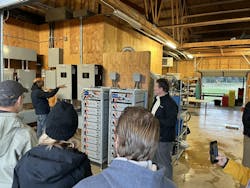Oregon Agrivoltaics-Based Microgrid Tackles Crop Warming from Climate Change – and May Improve Taste of Lettuce
At Our Table Cooperative, a farm south of Portland, Oregon, an agrivoltaics-based microgrid is expected to reduce crop warming from climate change, lower energy costs, provide resilience to the community and may even improve the taste of lettuce.
Agrivoltaics systems allow for simultaneously farming and deploying solar collectors so that farmers don’t have to choose between using their land to grow crops or install solar, said Chad Higgins, assistant professor at Oregon State University (OSU). Agricultural production takes place either below or next to the solar panels. When the crops are below the panels, the panels can provide shading that cools crops, said Higgins, who is a partner in the project.
Many Oregon farmers want to deploy solar and agrivoltaics
Many Oregon farms, like Our Table Cooperative, have expressed interest in agrivoltaics, said Dan Orzech, general manager at Oregon Clean Power Cooperative, which aims to increase the use of renewable energy in Oregon and is also a partner in the Our Table Cooperative project.
“We have a continual stream of people who want to do solar and/or agrivoltaics,” he said.
Our Table Cooperative’s interest in agrivoltaics began when Narendra Varma, executive director of the farm, began noticing that as Oregon summers have become hotter in response to climate change, the six-acre organic farm – which grows 40 to 50 types of vegetables and berries – has been 35% to 50% less productive.
“We have found that in the last three to four years, a lot of the crops in highest demand in summer – leafy greens – are suffering from warmer summers,” he said. “We wanted to figure out how to grow crops in a more economical fashion despite the warming climate. The obvious answer is shade.”
Hanging shade cloth was one option but because Oregon’s summer temperatures aren’t consistent, the farm wanted to install a form of shade that could be moved around.
Tracking solar collectors can provide shade that moves
To find a solution, the farm partnered with Oregon Clean Power Cooperative, OSU and Portland General Electric (PGE) to deploy tracking solar collectors that can move to provide shade.
“We now have these six poles with solar panels. We can control the tracking or create different shade patterns on the ground based on the crops and their needs,” said Varma.
This is where OSU comes in. Higgins, an agrivoltaics expert, will identify the best shade patterns based on the vegetables’ needs.
The “Lettuce Shine” project includes 75 kW of solar, energy storage and controls that will create a microgrid. The system is expected to meet 100% of the farm’s electricity needs.
With microgrid, farm will serve as resilience hub for community
The microgrid will ensure the farm can continue to operate cold storage facilities during outages, protecting the vegetables. The farm will also serve as a resilience hub for the community during outages, offering phone charging, air conditioning, heating and food from its store.
The recently commissioned grid-connected microgrid is enrolled in PGE’s net metering program but won’t be part of the utility’s smart battery program under which PGE pays customers to lend their batteries to support the grid during peak demand periods or energy emergencies, said Juliae Riva, PGE clean energy and environmental grants manager.
The dual axis tracking solar system is like a giant sunflower, explained Higgins.
“You have a single post and then on top of the post there's a 30-foot by 30-foot sail. That's the solar panels and they face the sun all day long.”
This is a more sophisticated system than the agrivoltaics installation at the Solar Harvest project in Aurora, Oregon, a partnership between Oregon Clean Power Cooperative and OSU’s College of Agriculture. It’s designed to allow researchers to study the impact of solar panels on soil health, water use and plant physiology and yields.
The Solar Harvest project only tracks the sun on one axis; OSU will plant some of the same vegetables at both sites and compare how the two different tracking systems affect vegetable growth. The dual axis tracking system is expected to generate 40% to 50% more solar than a ground-mounted system, said Varma.
Funding from PGE and IRA tax credits
PGE’s Renewable Development Fund provided a $267,000 grant for the Lettuce Shine project, and the farm has applied for a $20,000 grant from Energy Trust of Oregon. The total cost is expected to be about $475,000, said Varma. To fund the rest of the cost, the farm will apply for tax credits available under the Inflation Reduction Act and possibly pay out of pocket for the rest.
In addition to increasing productivity, the agrivoltaics system is expected to reduce the amount of water needed for the plants, said Higgins.
Before the microgrid system was installed, the lettuce was exposed to 30% to 50% more light than it could use physiologically, said Higgins. That warms the leaves up, but if they get too hot they draw water out of the soil and pump it through their leaves to cool off.
Cutting sun exposure reduces the need for water
By reducing the amount of sunlight that falls on the leaves, the project will reduce the amount of water needed. In general, shading plants by 30% reduces water demand by 30%, said Higgins.
The amount of irrigation that the farm will need for the lettuce will decrease by approximately the amount of sun that’s taken away, he said.
In addition to cutting water use, the project is expected to increase the flavor of the crops, said Higgins. He has gathered anecdotal evidence based on feedback from visitors to the Solar Harvest project that the fruits and vegetables grown with solar taste better.
He plans to confirm these anecdotes by creating a project – a “sensory panel” -- that will try to determine if people can taste the difference between crops grown with solar compared to those that aren’t grown with solar.
“The bottom line is I think we will be able to lengthen the harvesting window, save labor and save water, and increase the intensity of the flavor. Those are my three main hypotheses,” said Higgins.









